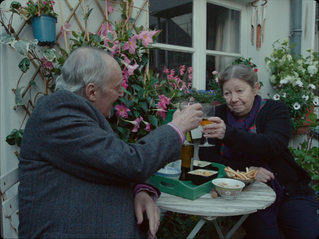Stop Making Sense
- Isobel Wise
- Mar 6, 2021
- 3 min read
Jonathan Demme, 1984

Hi, I’ve got a tape I want to play. Panning up from his white tennis shoes, David Byrne seems more square than rockstar. Frontman of Talking Heads, Byrne waltzes onto the screen to perform a stripped-back version of ‘Psycho Killer’; the bare stage and his oversized attire making the scene resemble a high school talent show, a maths teacher seizing hold of an acoustic guitar and portable tape player. With each song the stage becomes more crowded. Other musicians trickle in, stagehands set up mic stands and wheel out drum kits, until, by the fourth song on the set-list, every member of the band has convened.

As a concert film, Stop Making Sense boasts unparalleled originality. However, one does question what exactly the show is at times. A gig? Conceptual art performance? Off-broadway theatre production? During ‘Once in a Lifetime’, you could easily mistake the spectacle for some ecclesiastical convention—the audience, or rather congregation, in witness to the profferings of the Talking Heads megachurch. Yet it is precisely this inventive and diverse display that makes the film so visually and aurally arresting.
Byrne, who spends most of the show drenched with sweat, is formidable. His classically handsome and angular face contorts and shudders, his eyes wide and crazed. Flailing, quivering and gyrating to every beat, illustrating every lyric, his body—as if controlled by some extraneous force— is flung across the stage; he hobbles, careers around drum kits, and for a peculiarly tender moment in ‘This Must Be the Place’, partakes in a pas de deux with a floor lamp. It seems for Byrne the show is not merely a concert, but a cardio exercise program, each song assigned a routine of aerobics and sprinting. This choreography, performed by the frontman and band alike, is augmented by lighting. Flirting between colour and position, lights illuminate from every direction. This parade is announced in a flourish of blue, red and white, as shadows of the band—like those cast by a handheld light during ‘Girlfriend is Better’—frisk across the back of the stage enormous and disembodied. This particular song, perhaps most famous for the debut of Byrne’s big suit, is a paragon of the show’s oddball exuberance. The suit itself quite literally hangs off his body, vast swathes of fabric suspended by a girdle and webbed shoulder pads. As he moves, the suit sways with such exaggerated undulation that the result is at once cartoonish and effortlessly suave. In the song that follows this, Byrne unbuttons his jacket. Adopting the air of a commander, he slides his hands into his pockets and saunters around the stage; he is an overseer of precise and beguiling entertainment.

Launching into each song with relish, the band are acutely aware of their brilliance. Byrne struggles to suppress a perpetual smile, bassist Tina Weymouth dances with vocalists Lynn Mabry and Ednah Holt, whilst percussionist and promoter of unadulterated enthusiasm, Steve Scales, cavorts from one instrument to another. The band are not coy but never arrogant either. Indeed, what pervades the show is an innate earnestness, a genuine appreciation for the music, camaraderie and delight experienced up on stage. This joviality is infectious, and alongside the carefully considered set-list, prohibits the show from ever reaching a plateau. If Byrne’s idiosyncrasies are characterised by staccato, spasmodic motion, then the film itself moves towards its crescendo with celebratory ease.

Stop Making Sense is a masterful demonstration of showmanship. The performances, which extend beyond the music, are so memorable and infused with such unbridled passion that the result is inimitable euphoria. Possessing a frenetic, hypnotic, and ultimately very touching purity, the film is exhilarating and never feels contrived. It is sublime. Does anybody have any questions?








Comments